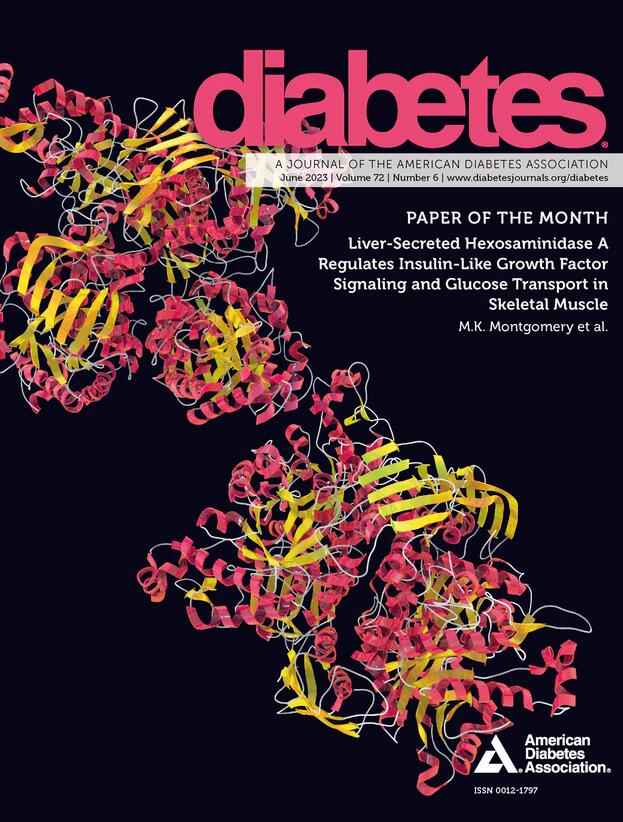1664-P:前列腺素E2刺激离体灌注大鼠小肠GLP-1分泌
IF 7.5
1区 医学
Q1 ENDOCRINOLOGY & METABOLISM
引用次数: 0
摘要
前言和目的:前列腺素(PG)刺激肠道粘液分泌和血流,但其在肠道激素分泌中的作用尚不清楚。相互矛盾的研究表明PG对激素和葡萄糖代谢有积极和消极的影响。我们旨在研究PGE2、PGD2、PGF2α和PGI2对小肠胰高血糖素样肽-1 (GLP-1)分泌的影响。方法:用改良的克雷布斯-林格碳酸氢盐缓冲液单遍灌注离体大鼠小肠。夹住动脉(7.5 mL/min)和管腔(0.250 mL/min)流量。在单独的实验中,PGE2 (10-9 M至10-5 M)、PGD2、PGF2α和PGI2 (0.1 μM, 1 μM)经血管内灌注10分钟,并冲洗20分钟。用放射免疫法测定GLP-1;通过单因素方差分析评估基线变化百分比。结果:输注1 μM PGE2显著增加GLP-1分泌(+206%,p=0.002;图C, D),但在1 nM (p=0.79), 10 nM (p=0.76), 100 nM (p=0.72)(图A, B)或10 μM (p=0.20;图C, D) (n=4)。PGD2 (0.1 μM: p=0.56;1 μM: p= 0.99), PGF2α (0.1 μM: p=0.78;1 μM: p= 0.99),而PGI2 (0.1 μM: p=0.92;1 μM: p=0.40)刺激GLP-1分泌。结论:PGE2独特刺激灌注大鼠小肠GLP-1分泌,呈钟形剂量反应曲线。这将炎症介质与肠道保护激素的释放联系起来。j·k·弗里斯:没有。T.A.库克森:没有。莫迪格:没有。阿爸:没有。J.J.霍尔斯特:顾问小组;诺和诺德公司顾问;诺和诺德公司其他关系;诺和诺德公司顾问;阿斯利康,Fractyl Health, MSD生命科学基金会,Structure Therapeutics, Inc。维德菲尔德:没有。丹麦森林森林基金(3101-00127A)本文章由计算机程序翻译,如有差异,请以英文原文为准。
1664-P: Prostaglandin E2 Stimulates GLP-1 Secretion in the Isolated Perfused Rat Small Intestine
Introduction and Objective: Prostaglandins (PG) stimulate intestinal mucous secretion and blood flow, but their role in gut hormone secretion remains ambiguous. Conflicting studies suggest both positive and negative effects of PG on hormone and glucose metabolism. We aimed to investigate the effects of PGE2, PGD2, PGF2α, and PGI2 on small intestinal glucagon-like peptide-1 (GLP-1) secretion. Methods: Isolated rat small intestine was vascularly perfused using a single-pass system with a modified Krebs-Ringer bicarbonate buffer. Arterial (7.5 mL/min) and luminal (0.250 mL/min) flow were clamped. In separate experiments, PGE2 (10-9 M to 10-5 M), PGD2, PGF2α, and PGI2 (0.1 μM, 1 μM) were infused intravascularly for 10-minutes with 20-minute washouts. GLP-1 was measured by radioimmunoassay; percent change from baseline was assessed by one-way ANOVA. Results: Infusion of 1 μM PGE2 significantly increased GLP-1 secretion (+206%, p=0.002; Fig C, D), but not at 1 nM (p=0.79), 10 nM (p=0.76), 100 nM (p=0.72) (Fig A, B) or 10 μM (p=0.20; Fig C, D) (n=4). Neither PGD2 (0.1 μM: p=0.56; 1 μM: p>0.99), PGF2α (0.1 μM: p=0.78; 1 μM: p>0.99), nor PGI2 (0.1 μM: p=0.92; 1 μM: p=0.40) stimulated GLP-1 secretion. Conclusion: PGE2 uniquely stimulates GLP-1 secretion in the perfused rat small intestine, exhibiting a bell-shaped dose response curve. This links inflammatory mediators to gut-protective hormone release. Disclosure J.K. Friis: None. T.A. Cookson: None. I.M. Modvig: None. V. Abba: None. J.J. Holst: Advisory Panel; Novo Nordisk A/S. Consultant; Novo Nordisk A/S. Other Relationship; Novo Nordisk A/S. Consultant; AstraZeneca, Fractyl Health, Inc., MSD Life Science Foundation, Structure Therapeutics, Inc. S. Veedfald: None. Funding Dansk Frie Forskningsråd (3101-00127A)
求助全文
通过发布文献求助,成功后即可免费获取论文全文。
去求助
来源期刊

Diabetes
医学-内分泌学与代谢
CiteScore
12.50
自引率
2.60%
发文量
1968
审稿时长
1 months
期刊介绍:
Diabetes is a scientific journal that publishes original research exploring the physiological and pathophysiological aspects of diabetes mellitus. We encourage submissions of manuscripts pertaining to laboratory, animal, or human research, covering a wide range of topics. Our primary focus is on investigative reports investigating various aspects such as the development and progression of diabetes, along with its associated complications. We also welcome studies delving into normal and pathological pancreatic islet function and intermediary metabolism, as well as exploring the mechanisms of drug and hormone action from a pharmacological perspective. Additionally, we encourage submissions that delve into the biochemical and molecular aspects of both normal and abnormal biological processes.
However, it is important to note that we do not publish studies relating to diabetes education or the application of accepted therapeutic and diagnostic approaches to patients with diabetes mellitus. Our aim is to provide a platform for research that contributes to advancing our understanding of the underlying mechanisms and processes of diabetes.
 求助内容:
求助内容: 应助结果提醒方式:
应助结果提醒方式:


